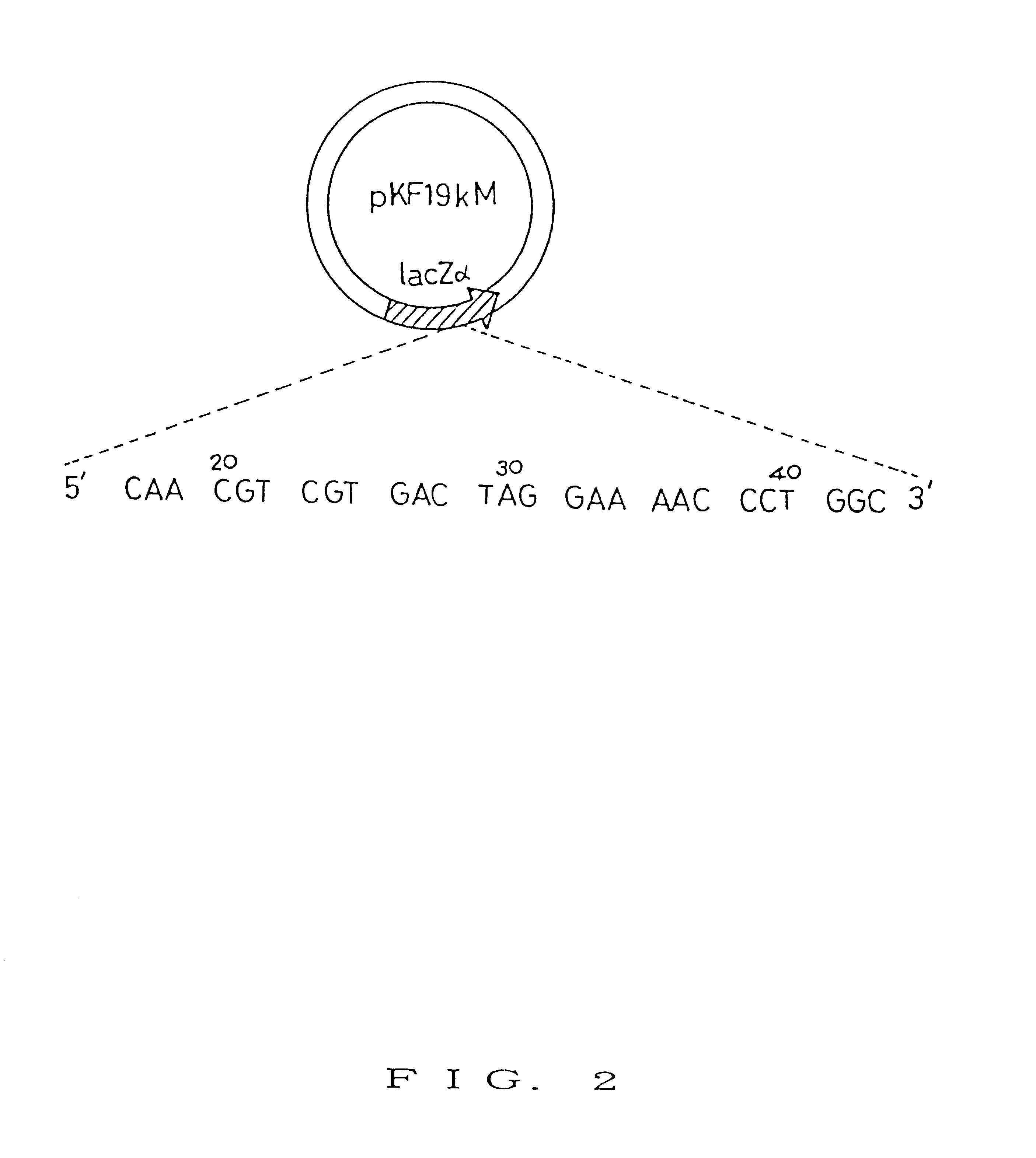Method for effecting site-directed mutagenesis
a site-directed mutagenesis and site-directed technology, applied in biochemistry apparatus and processes, organic chemistry, sugar derivatives, etc., can solve the problems of complex procedures, difficult to obtain large amounts of gene products, and extremely low ratio of mutants to parent dna
- Summary
- Abstract
- Description
- Claims
- Application Information
AI Technical Summary
Benefits of technology
Problems solved by technology
Method used
Image
Examples
example 2
Three Bases- or 6 Bases-Deletion Site-Directed Mutagenesis
pKF19k (manufactured by Takara Shuzo Co., Ltd., FIG. 1) was used to delete 3 bases or 6 bases, the pKF19k containing wild type lacZ' gene and kanamycin resistance gene with two amber codons.
1. Synthesis of Mutagenic Oligonucleotide
The 5'-terminal phosphorylated oligonucleotide was synthesized so as to lack a BamHI site and BamHI-EcoRI site in the multicloning site on pKF19k by 3-bases or 6-bases deletion, respectively. An oligonucleotide used in 3-bases deletion (dell) is shown by SEQ ID NO: 3 in Sequence Listing. An oligonucleotide used in 6-bases deletion (del2) is shown by SEQ ID NO: 4 in Sequence Listing. Specifically, dell was designed to delete bases at the positions between 12th G and 13th C of SEQ ID NO: 3 in Sequence Listing, and del2 was designed to delete bases at the positions between 12th G and 13th T of SEQ ID NO: 4 in Sequence Listing.
2. PCR and Transformation
Thirty cycles of PCR where each of cycles consisted ...
example 3
Sixty Bases-Deletion Site-Directed Mutagenesis
1. Synthesis of Mutagenic Oligonucleotides
A 5'-terminal phosphorylated oligonucleotide was synthesized so as to lack a whole multicloning site (60 bases) of pKF19k (manufactured by Takara Shuzo Co., Ltd.) by deletion. The oligonucleotide (de13) is shown by SEQ ID NO: 5 in Sequence Listing. In other words, del3 was designed so as to delete a whole multicloning site (60 bases) at the position between 10th T and 11th G of SEQ ID NO: 5 in Sequence Listing.
2. PCR and Transformation
Thirty cycles of PCR where each of cycles consisted of the conditions of 94.degree. C. for 30 seconds, 50.degree. C. for 2 minutes, and 72.degree. C. for 2 minutes were carried out by using primer del3 prepared in item 1 in Example 3 and KQ2 primer used in Example 1 according to the composition of Table 1 (in the table, pKF19k was used in place of pKF19M). The resulting PCR product was then subjected to ethanol precipitation in the same manner as in Example 1. There...
example 4
Deletion and Insertion Site-Directed Mutagenesis
1. Synthesis of Mutagenic Oligonucleotides
The 5'-terminal phosphorylated oligonucleotide was synthesized so as to introduce an additional EcoRI site at 100th base downstream from EcoRI site in multicloning site of pKF19k. The oligonucleotide (eco1) is shown by SEQ ID NO: 6 in Sequence Listing. In other words, eco1 was designed so as to delete bases AAT of original sequence corresponding to bases at the positions of from 9th G to 14th C, and to insert an ECORI site, GAATTC.
2. PCR and Transformation
Twenty-four cycles of PCR where each of cycles consisted of the conditions of 94.degree. C. for 30 seconds, 55.degree. C. for 2 minutes, and 72.degree. C. for 2 minutes were carried out, by using primer ecol prepared in item 1 in Example 4 and KQ2 primer used in Example 1, according to the composition of Table 1 (in the table, pKF19k was used in place of pKF19M). The resulting PCR product was then subjected to ethanol precipitation in the same...
PUM
| Property | Measurement | Unit |
|---|---|---|
| length | aaaaa | aaaaa |
| size | aaaaa | aaaaa |
| drug-resistance | aaaaa | aaaaa |
Abstract
Description
Claims
Application Information
 Login to View More
Login to View More - R&D
- Intellectual Property
- Life Sciences
- Materials
- Tech Scout
- Unparalleled Data Quality
- Higher Quality Content
- 60% Fewer Hallucinations
Browse by: Latest US Patents, China's latest patents, Technical Efficacy Thesaurus, Application Domain, Technology Topic, Popular Technical Reports.
© 2025 PatSnap. All rights reserved.Legal|Privacy policy|Modern Slavery Act Transparency Statement|Sitemap|About US| Contact US: help@patsnap.com


